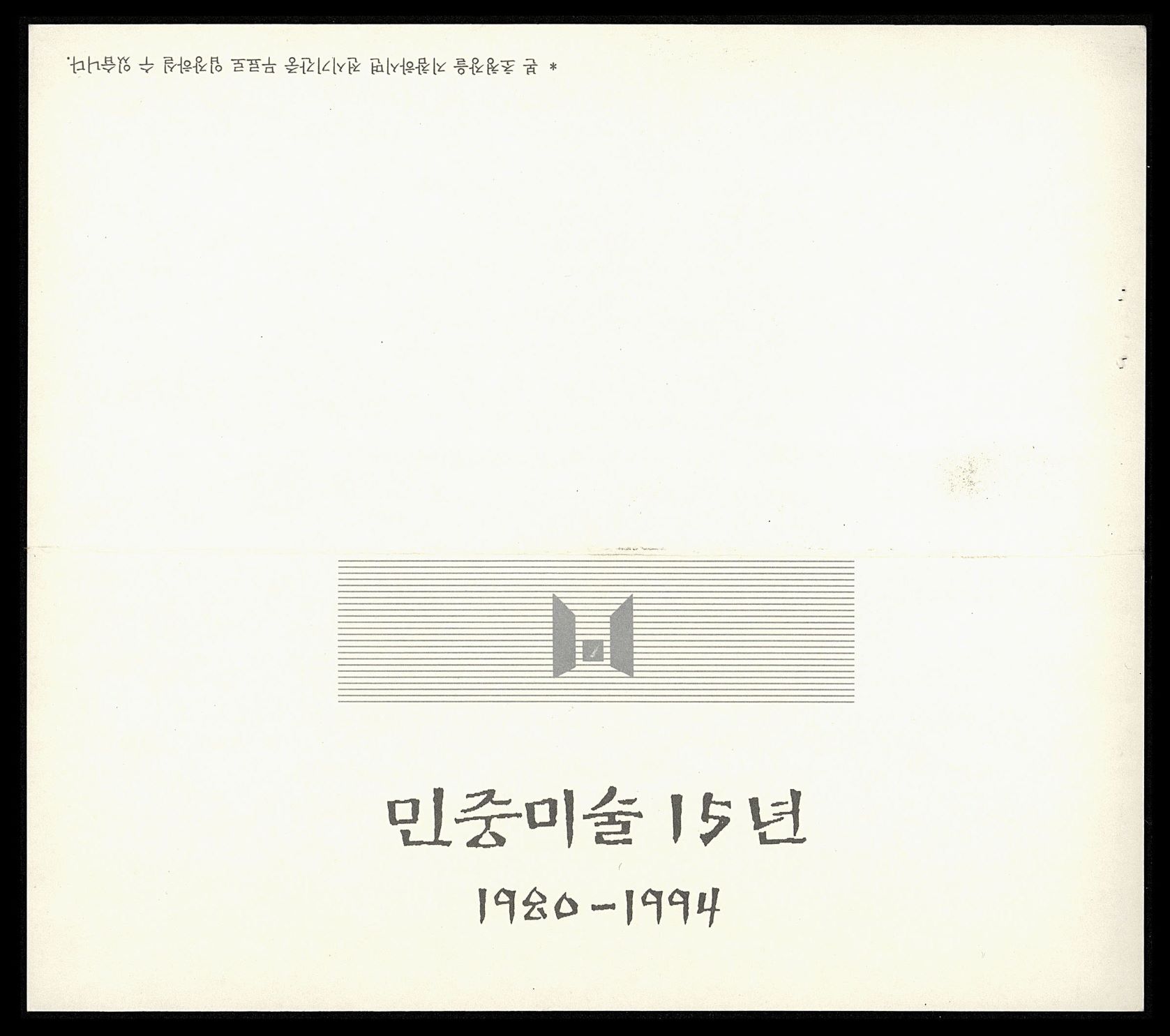
The 15 Years of Korean Minjoong Arts: 1980-1994 Invitation, 1994, MMCA Art Research Center Collection
Minjung Art
* Source: Multilingual Glossary of Korean Art by Korea Arts Management Service
Related
-
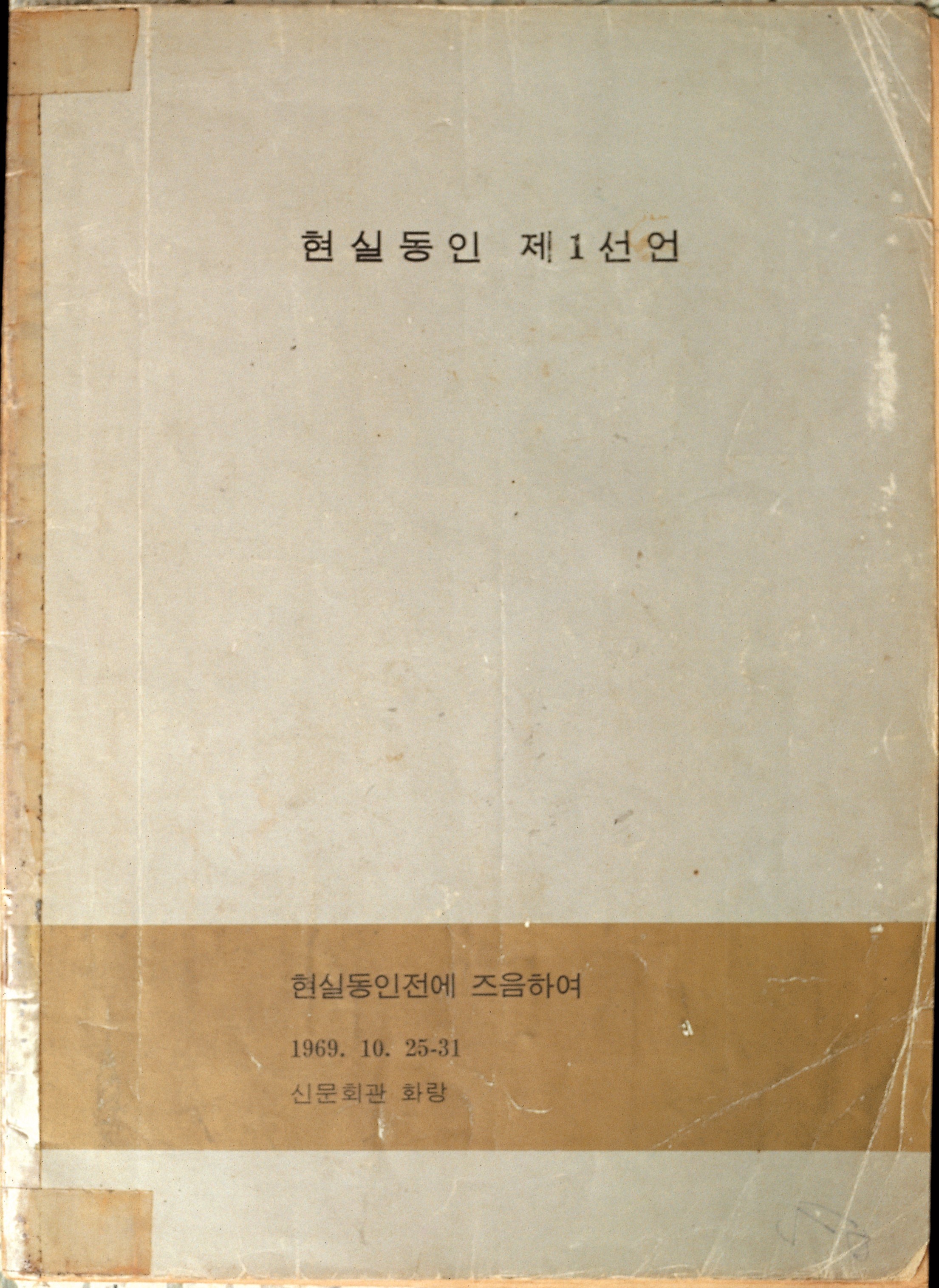
Reality Group
An artists’ group concerned with the creation of a national aesthetic and realism. The group was formed by Oh Yoon, Lim Setaek, and Oh Kyunghwan, who were students at the Seoul National University College of Fine Arts in 1969. The inaugural exhibition of Reality Group was originally planned to be held at the Sinmunhoegwan Gallery from October 25 to 31, 1969, but the exhibition was canceled due to pressure from local authorities, after it was reported to the government by the university. However, knowledge about the existence of the group and its aims resulted from the inclusion of the 1st Declaration of the Reality Group (written by aesthetics major Kim Jiha and edited by Kim Yoon-Soo) in the catalogue for the inaugural exhibition. The stated goal of the Reality Group was to establish a new national art theory based on realist art that could usefully account for Korean tradition of visual culture. This influence of this approach was kept alive through Oh Yoon’s participation in the Reality and Utterance (Hyunsilgwa bareon) of the 1980s.
-
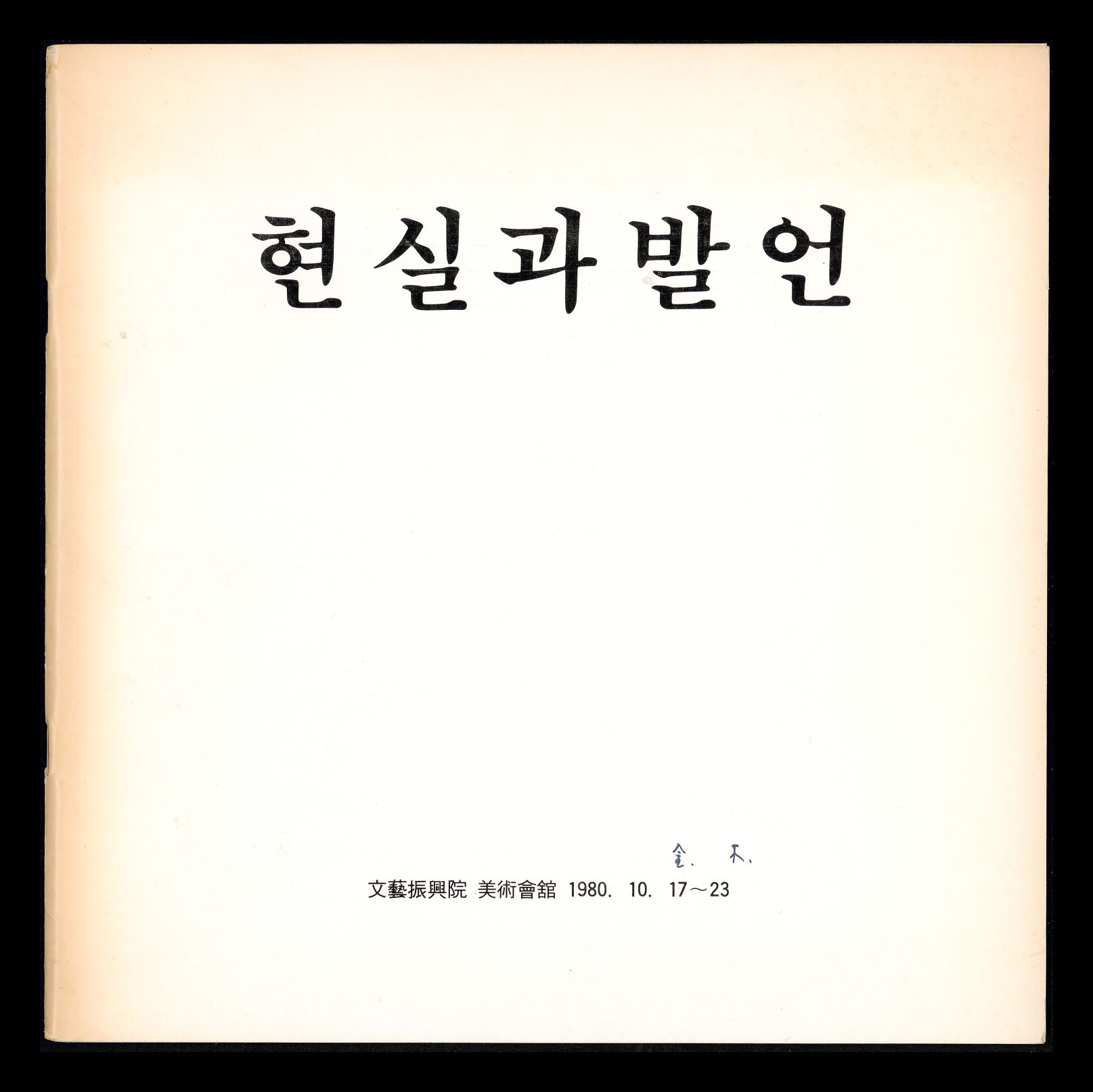
Reality and Utterance
A group formed in 1979 by artists and critics that criticized the contradictory nature of industrial society and the conservatism of the art community. The group formed during preparations for an exhibition to mark the 20th anniversary of the 1960 April Revolution. The group emphasized a realistic attitude, namely that art must depict reality and reveal the underlying contradictions of society. The group borrowed from or copied pop culture images, and also used photography, prints, comics, reproductions, and collages. Such methods were considered a means to help critically address the overabundance of visual images in contemporary Korean society, the issues of urbanization, and the colonial nature of Korean culture.
-

Oh Yoon
Oh Yoon (1946-1986) is a sculptor, printmaker, and painter who participated in the Minjung art movement in the 1980s. He graduated from the Department of Sculpture at the College of Fine Arts, at Seoul National University. In 1969, while still a student at Seoul National University, he participated in the preparation of the inaugural exhibition of Reality Group [Hyeonsil dongin] with Kim Yoon-Soo, Kim Jiha, Oh Kyunghwan, and Lim Setaek, and began to explore the socially critical Minjung art movement. After graduating from university, he stayed in Gyeongju for two years to study traditional arts, such as stone Buddhist sculptures and terracotta figurines and set up a tile factory in Byeokje to start working with terracotta. The terracotta relief mural on the interior wall of the Guui-dong Branch of the Commercial Bank in Seoul and the terracotta relief mural on the exterior wall of the Dongdaemun Branch of the Commercial Bank are examples of his work from this period. In 1979, Oh Yoon participated as a founding member of Reality and Utterance [Hyeonsilgwa bareon] and continued to exhibit in the members’ exhibitions of Reality and Utterance, exhibiting socially engaged paintings, woodblock prints and banner paintings. His works evolved from his interest in the lives of laborers and peasants, and folk culture such as traditional performing arts and folktales. In the 1980s, he perfected his woodblock print style, focusing on portraits that exquisitely expressed condensed power and Korean sentiments of han (resentment) and sinmyeong (mirth). He created woodblock illustrations and covers for a number of publications, including Kim Jiha's Ojeok (Five thieves), and in 1986 he published a book of woodblock prints, Kal norae (song of sword). His representative works include the series Marketing, Dawn of Labor (1985), and the large banner painting, Great Desires for Unification (1985).
Find More
-

Imsulnyeon
Imsulnyeon (literally, “Imsul year”) was a small Minjung art collective founded in 1982 and active until 1987. Its official name is “Imsulnyeon, from Ninety-eight Thousand, Nine Hundred Ninety-two.” Imsulnyeon started in the late 1970s when Park Heungsoon, Chun Junyeop, Lee Jonggu, and Hwang Jaihyoung, who were students returning to the Department of Painting at Chung-Ang University, held a discussion meeting. They emphasized the significance of the “homogeneity of consciousness” and believed that the “basic skills of a painter” should be considered in depth. Upon the recommendation of their junior Lee Myoungbok and other internal members, seven artists including Song Chang (Chosun University) and Chun Kwangho (Yeungnam University) held the inaugural exhibition in October 1982 at the Duksoo Museum. Imsulnyeon was a group that regarded highly the existential and realistic thesis of the “here and now.” “Imsulnyeon” corresponds to the year 1982, and “Ninety-eight Thousand, Nine Hundred Ninety-two” is the gross area of South Korea. In their manifesto, the Imsulnyeon states that “the perspective we wish to hold is the naked reality or hidden truth of our time” and that “we will honestly visualize the uncertain transitional situation that exists in the real world.” The regular exhibition The Second Imsulnyeon, from Ninety-eight Thousand, Nine Hundred Ninety-two was held in November 1983 at the Arab Art Museum, and in April of the same year it was re-held in Daegu on the invitation of the Daegu Su Gallery. In January of the following year, another invitational exhibition was held at the Academy Art Museum in Gwangju, and in November, the third regular exhibition was held at Baeksang Memorial Hall. Imsulnyeon held its fourth regular exhibition in October 1985 at the Hangang Museum and the fifth edition in November at Min Art Gallery (Geurim Madang Min). After an invitational exhibition at Taebaek Gallery in Daegu in January 1987, Imsulnyeon disbanded with the last regular exhibition at Haein Gallery in Busan. In the second regular exhibition, Kwon Yonghyeon, Song Juseop, and Jo Jinho newly participated in the exhibition; in the fourth, Lee Seongwan; and in the fifth, Han Huiwon joined. They wanted to paint the reality that they had seen with their own eyes and experienced. Therefore, when the inaugural exhibition ended, they dispersed in search of their own themes. Park Heungsoon produced Boxer; Lee Myungbok, Iteawon; Song Chang, Division; Lee Jonggu, Oji-ri; Chun Junyeop, Urban Landscape; Chun Kwangho, Generation Landscape; and Hwang Jaihyoung, Taebaek Coal Mining Village. The artists who later joined the Imsulnyeon also devoted themselves to making paintings with distinct themes. Most of their works were enormous in size and showed a dense sense of completeness. The emergence of Imsulnyeon, founded in 1982, attracted great attention from other artists from the Minjung art scene by successfully solving the problem of “reality” at a time when the aesthetics of Minjung art were just budding. However, it was disbanded in 1987 due to different reasons, such as difference in views among its members followed by internal conflicts within the National Art Association [Minjok misul hyeopuihoe] and issues in visual representation.
-
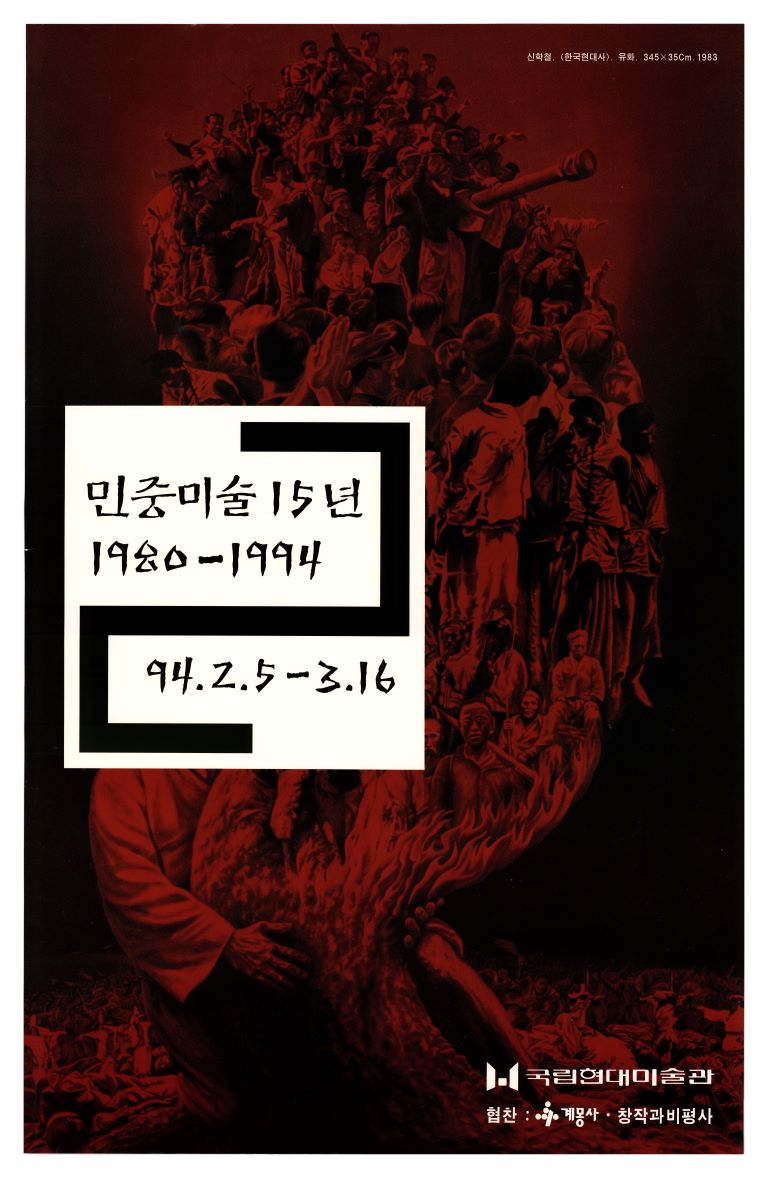
15 Years of Korean Minjoong Arts: 1980-1994
Fifteen-Years of Minjung Art was a historical exhibition held at the National Museum of Modern and Contemporary Art from February 5 to March 16 in 1994. This monumental exhibition comprehensively covered the history and achievements of the Minjung Art movement during the 1980s. The initial idea for the exhibition began in early 1993 when Minjung artists visited the director of the National Museum of Modern and Contemporary Art to talk about the essential need for an exhibition on Minjung Art, in relation to the recent completion of the struggle for democracy that took place over the 1980s. The exhibition consisted of four sections - “Formation of Minjung Art,” “Achievements of Banner Paintings and Collaborative Creation” “Expansion and Improvement of Minjung Art,” and “Achievement and Advancement of Creation.” A Total of 389 works, including 234 paintings, 68 prints, and 200 related documents were exhibited. Some art critics pointed out the limitations of the Minjung Exhibition due to its lack of overall clear organization, the apparently undiscerning selection of artworks and artists, and other issues regarding curation and arrangement. With the completion of the exhibition many critics questioned the apparent institutionalization of Minjung Art given its approval by the governmental authorities, and the subsequent absence of a clear future direction for the movement given its previous primary anti-authoritarian rationale.
-
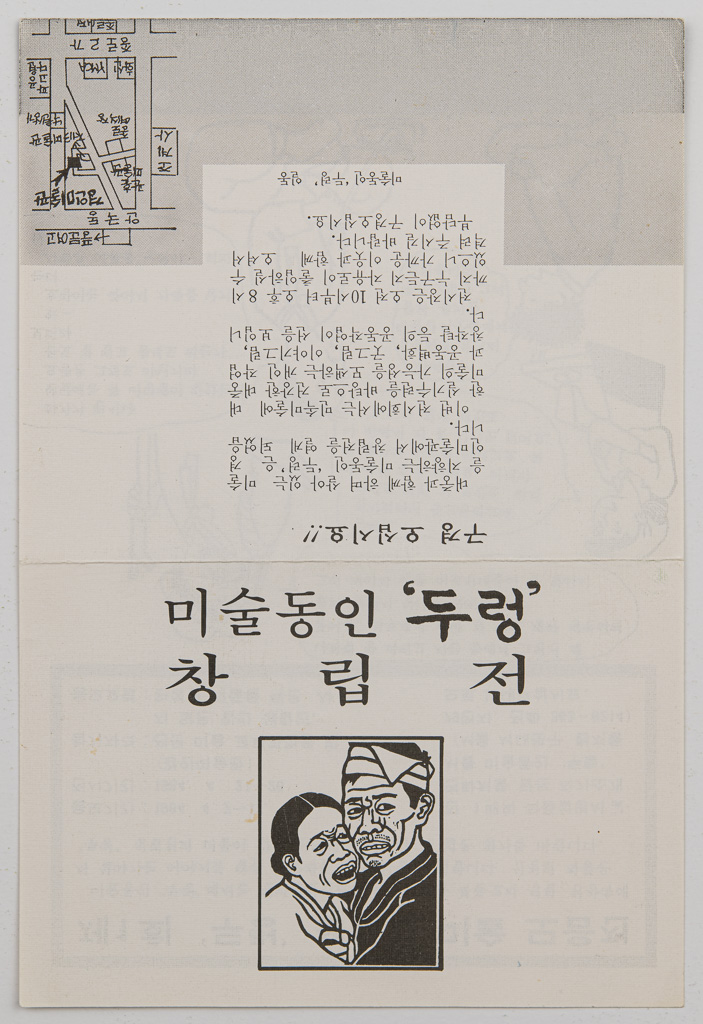
Dureong
Dureong was an art group founded in 1982 primarily comprised of Hongik University alumni that emphasized the ideology of Minjung Art. The group particularly rejected the use of Western methods and individualism that were adopted by the art group Reality and Utterance [Hyunsilgwa bareon]. Instead, they sought to create ethnically Korean, contemporary grass-roots art and develop more populist methods of expression. They aimed to create art that was relevant to the everyday lives of contemporary people rather than “nihilistic and commercialized sick paintings.” Their name originated from their periodicals Live Paintings and Live Art. The Dureong focused on ordinary people to foster art work based on everyday lives with the aim to educate people’s cultural sensibility. They also conducted research into traditional folk art, which they assumed as the origin of Korean Minjung art, and inherited the legacy of this work, in terms of trying to produce an art history relevant to ordinary people. They also emphasized collaborative projects as a means to democratize art production. The group engaged in joint projects for grassroots art, the creation of murals and prints, and ethnically grounded Korean art education until 1987.






